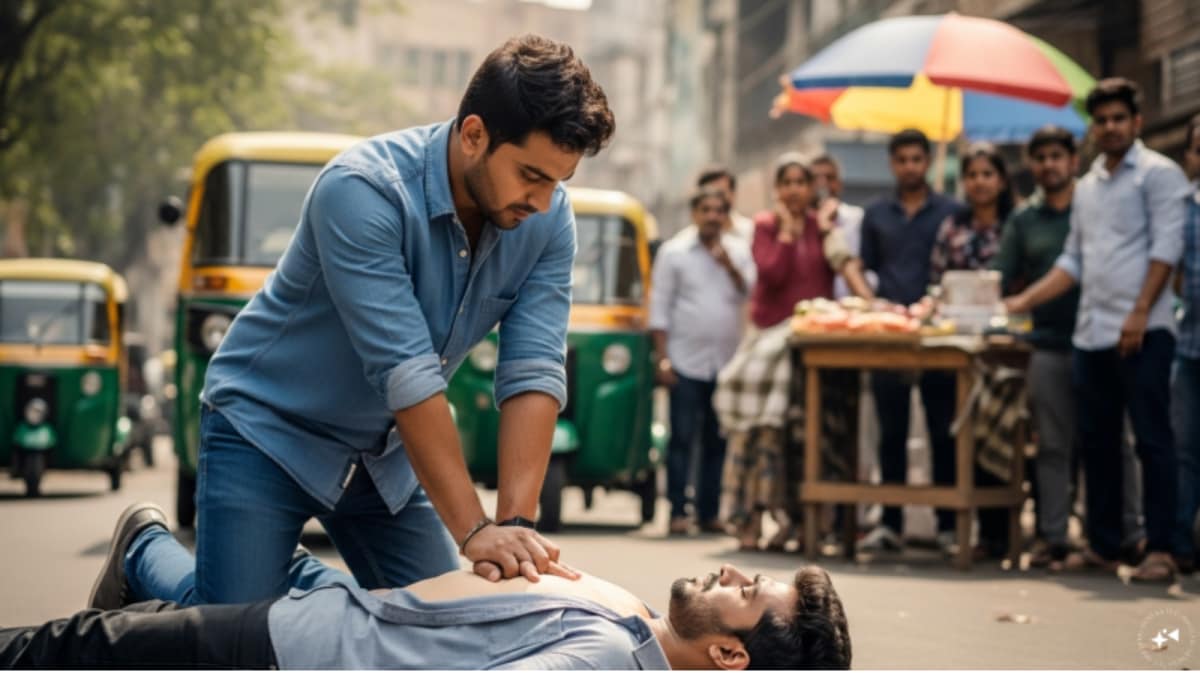Last Updated:
If medical help isn’t immediately available, CPR can be life-saving. Dr. RP Singh stressed performing it correctly and promptly to increase survival chances

The doctor provided a live demonstration of the CPR technique and detailed the correct procedure. (AI Generated)
A special workshop was organised at the Deen Dayal Upadhyaya Junction (DDU) RPF New Loco Barracks, where officers and soldiers of the Railway Protection Force (RPF) received practical training on administering CPR (Cardiopulmonary Resuscitation) in cases of heart attacks. The aim of this training was to equip the soldiers with the skills needed to provide immediate life-saving assistance during emergencies.
Quick CPR Can Save A Life
Dr. R.P. Singh from the Divisional Railway Hospital, DDU, explained that during a heart attack, the heart stops pumping and the pulse ceases. If medical aid is not immediately accessible, CPR can be crucial in saving lives. Dr. Singh emphasised the importance of performing CPR correctly and promptly to maximise the chances of survival before reaching a hospital.
Can Be Performed Even Without Formal Training
Pradeep Kumar Rawat explained that CPR is an emergency procedure used when a person’s breathing or heartbeat stops, such as during a heart attack or drowning. He noted that even individuals without formal training can administer CPR by applying strong and deep chest compressions, potentially saving lives.
Live Demonstration Of The CPR Technique
During the training session, inspector Pradeep Kumar Rawat, inspector Shahid Khan from Manas Nagar, sub-inspector R.N. Ram, Amarjeet Das, Indra Kumar, Ajay Sahni, Shivshankar Yadav, and Arvind Kumar Yadav actively participated. The doctor provided a live demonstration of the CPR technique and detailed the correct procedure to the soldiers.
At the conclusion of the programme, all soldiers pledged to make every effort to save the lives of any unconscious or distressed persons by administering CPR. Officials described this initiative as a significant step not only in technical knowledge but also in the protection of human life.
Here’s A Step-By-Step Guide On How To Give CPR
Step 1: Check The Scene And The Person
- Make sure the area is safe.
- Tap the person’s shoulder and check if they are fine.
- Look for normal breathing (not gasping) for no more than 10 seconds.
- If unresponsive and not breathing normally, begin CPR immediately.
- If breathing normally, the body should be placed in recovery position and monitored until help arrives.
Step 2: Call For Help
- Call emergency services or ask someone nearby to call.
- If possible, put the phone on speaker mode so that CPR can be started while talking to the dispatcher.
- Ask for an AED (Automated External Defibrillator) if one is available.
Step 3: Position Your Hands
- Place the heel of one hand in the center of the chest, on the lower half of the breastbone.
- Place the other hand on top, interlocking the fingers.
- Keep the arms straight, shoulders directly above the hands.
Step 4: Start Chest Compressions
- Push hard and fast in the center of the chest.
- The compression depth should be about 2 inches (5 cm) for adults.
- The rate should be around 100–120 compressions per minute.
- Allow the chest to fully rise after each compression.
Step 5: Give Rescue Breaths
- After every 30 compressions, give 2 rescue breaths.
- Tilt the person’s head back and lift the chin.
- Pinch the nose shut, seal your mouth over theirs.
- Blow for one second, enough to make the chest rise.
- Repeat once.
Continue 30 chest compressions and two rescue breaths until the person starts breathing, an AED becomes available, emergency help takes over, or one becomes too exhausted.
Step 6: Use An AED
- Turn on the AED and follow its voice instructions.
- Expose the chest, attach pads as shown in the diagrams.
- Make sure no one is touching the person during analysis or shocks.
- Continue CPR when prompted by the device.
Mughalsarai Railway Settlement, India, India
October 22, 2025, 15:54 IST







